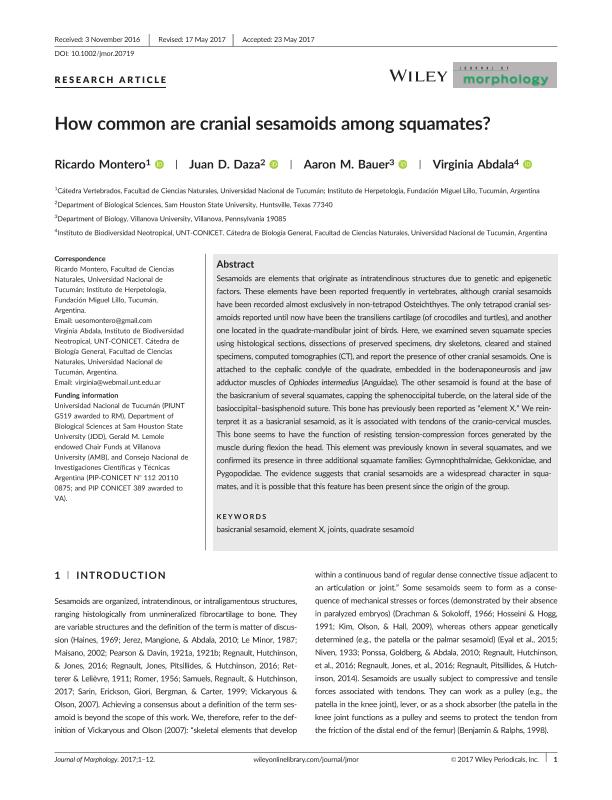Artículo
How common are cranial sesamoids among squamates?
Fecha de publicación:
10/2017
Editorial:
Wiley-liss, Div John Wiley & Sons Inc
Revista:
Journal of Morphology
ISSN:
0362-2525
Idioma:
Inglés
Tipo de recurso:
Artículo publicado
Clasificación temática:
Resumen
Sesamoids are elements that originate as intratendinous structures due to genetic and epigenetic factors. These elements have been reported frequently in vertebrates, although cranial sesamoids have been recorded almost exclusively in non-tetrapod Osteichthyes. The only tetrapod cranial sesamoids reported until now have been the transiliens cartilage (of crocodiles and turtles), and another one located in the quadrate-mandibular joint of birds. Here, we examined seven squamate species using histological sections, dissections of preserved specimens, dry skeletons, cleared and stained specimens, computed tomographies (CT), and report the presence of other cranial sesamoids. One is attached to the cephalic condyle of the quadrate, embedded in the bodenaponeurosis and jaw adductor muscles of Ophiodes intermedius (Anguidae). The other sesamoid is found at the base of the basicranium of several squamates, capping the sphenoccipital tubercle, on the lateral side of the basioccipital–basisphenoid suture. This bone has previously been reported as “element X.” We reinterpret it as a basicranial sesamoid, as it is associated with tendons of the cranio-cervical muscles. This bone seems to have the function of resisting tension-compression forces generated by the muscle during flexion the head. This element was previously known in several squamates, and we confirmed its presence in three additional squamate families: Gymnophthalmidae, Gekkonidae, and Pygopodidae. The evidence suggests that cranial sesamoids are a widespread character in squamates, and it is possible that this feature has been present since the origin of the group.
Palabras clave:
Basicranial Sesamoid
,
Element X
,
Joints
,
Quadrate Sesamoid
Archivos asociados
Licencia
Identificadores
Colecciones
Articulos(IBN)
Articulos de INSTITUTO DE BIODIVERSIDAD NEOTROPICAL
Articulos de INSTITUTO DE BIODIVERSIDAD NEOTROPICAL
Citación
Montero, Ricardo; Daza, Juan D.; Bauer, Aaron M.; Abdala, Virginia Sara Luz; How common are cranial sesamoids among squamates?; Wiley-liss, Div John Wiley & Sons Inc; Journal of Morphology; 278; 10; 10-2017; 1400-1411
Compartir
Altmétricas




